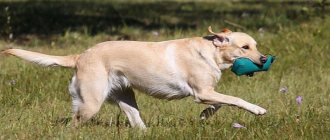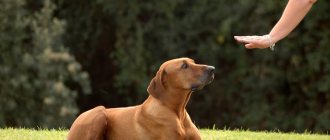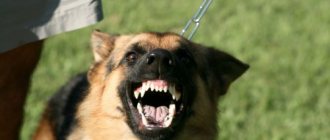There is a general training course that includes not only basic skills, but also the “Fetch!” command. Not all novice dog breeders know what it can mean, as well as how to properly train an animal. In this article we will talk about how to teach a dog the “Fetch!” command.
So that from the first days the puppy understands who is the boss in the house and does not begin to dominate the person by dictating his own rules, it is important to immediately begin training the pet. Experts believe that teaching a dog to fetch things thrown into the distance is possible without the help of an experienced dog handler. Not everyone knows what the word “fetch” is for a dog. This is a skill that encourages the animal to run, pick up from the ground, return, walk around the owner on the right and sit on the left.
Training is carried out with a puppy aged 7-8 months, who already knows and carries out basic commands: “Come to me!”, “Near!” and “Sit!” The benefits of mastering the skill of bringing and giving an object to the owner are obvious: the dog gets used to looking for something and navigating in space, is involved in an interesting game process, using the organs of vision, hearing, smell and all types of its memory.
A conditioned reflex is also developed - the pet learns to build logical chains. Your pet must not only bring back what was thrown, but also learn to control his emotions and be patient, since the prey will have to be given back after the chase and search.
This skill will also allow a pet, whose owner, due to a busy work schedule, cannot walk with him for a long time, get the necessary physical activity.
Choosing a retrieval item
To train your dog independently, you need to prepare equipment. This primarily concerns fetch items, which can be frisbees, rubber bones, or special bones from a pet store. A squeaky toy or any ball is also suitable, preferably the size of a tennis ball. A plastic bottle filled with water, cereal or sand, or even a simple stick found on the street, will do the job perfectly.
In order for the animal to quickly get involved in the learning process and get used to it, it is advisable to use one thing all the time. It is not recommended to use soft toys for such purposes, as they can quickly become dirty and damage your pet’s teeth. Items should have a streamlined shape and light weight.
Learning algorithm
Some owners claim that there are breeds of dogs that cannot be trained to fetch sticks and other objects, but this only means that the owner lacks the patience or skill to engage the animal. The easiest children to learn are those who love to scratch their teeth and play.
Much depends on temperament - training with a phlegmatic or melancholic person will take more effort and time. Functionally, the process consists of executing the commands “Take!”, “Bring!” and “Give it back!”
Take it
The owner and the animal take their positions - he is on the lawn in a free position, the dog sits or lies at the owner’s left leg. You need to show what will later become your pet’s prey, tease the animal a little, and give him the opportunity to try it out. During the game, it is recommended to repeat the word “Take!”
You should drop what the owner has chosen, interest the dog in the process of playing, so that he wants to pick it up from the ground, but do not force it. Toys and other objects are prohibited from tearing or running away from the trainer with them. Gradually you need to increase the throwing distance, but do not untie the dog. When he learns to pick up something thrown at a distance of several meters, he can move on to learning the next skill.
Tell the dog “Bring it!” permissible only once, and he must obey. The offering and the process of transferring things to the owner is carried out without using the orders “Come to me!” and “Ugh!” You should not allow your pet to tease the trainer with objects; it is important to teach him the ability to give up prey and cope with his emotions that prevent this.
Throw the object of pursuit several meters into the distance, and when the dog picks it up, command “Bring it!”, and do not forget to slap your hand on the knee. The last gesture replaces the order “Come to me!” When the pet masters this skill, he will have to present objects to the owner without visual or vocal accompaniment.
Give it back
The animal will probably try to run away with the prey, but the trainer needs to carefully pull it towards him. It may be advisable to walk around behind your pet and sit him in front of you. With his free hand, the owner takes the prey, monitors the dog’s reaction, and then carefully pulls it towards himself. If the animal tries to dodge, use a jerk with the leash.
The dog should hold what he has caught for no more than 15 seconds; most likely, he will want to release it from his mouth himself so that the owner will throw it again. Next, you need to command “Give!”, then praise and encourage your four-legged friend, and then repeat the exercise.
When training your pet to fetch fetch items, you should remember that dogs do not like to take things into their mouths that are covered with long fur or feathers. During the training process, the commands are repeated 3-4 times, followed by a break of up to 10 minutes. They move on to the next stage after the dog has learned the previous skill.
According to veterinarians, every dog needs training in certain commands. Of course, for service dogs the list of required skills is strictly specified, but pets may only know a few commands, for example, “Fetch”, “Foo”, “Come to me”, etc.
Teaching your pet one or another “trick” allows you not only to diversify daily walks, but to develop obedience in the animal, correct perception of the world, and add physical activity, which will have a beneficial effect on health.
Don’t think that the “Fetch” command, familiar to many, is just a game for a dog. In fact, when a dog runs and gives an object on command, he develops a lot of useful skills that will be useful to him in the future.
How to teach your dog the command "Fetch the leash"?
This command contains several actions. First, the dog goes to look for its leash, then it must bring it to the owner. To make training go faster, it is advisable to always leave the leash in a certain place. Moreover, in such a way that the animal would have access. Give me the leash!” sounds.
“, the dog goes for the leash to the place where it is always located, takes it with its teeth or removes it from the hanger.
After this, the pet gives the leash to the owner. Moreover, the dog must hold the leash until you take the leash from it. You should not allow your pet to throw its leash on the floor.
In addition, this command can be taught in reverse order. That is, in reverse order. The owner holds the leash in his hands, then gives it to the dog, and then takes it away. And this needs to be done several times. After that, the leash is taken into the room and the dog is sent to search for it. In any training, the pet must gradually move from ordinary, familiar commands to more complex ones.
Dogs will follow your commands without any problems if you praise them and treat them with various tasty “things.”
- — we call the dog, hand it a leash and invite it to take it and hold it with its teeth;
- — while the animal is holding the leash in its teeth, we move away from it a couple of steps. The pet must follow us, holding the leash, and not throw it to the ground;
- — put the leash on the ground and ask the dog to pick it up;
- - put the leash on the table, but do not praise the dog until he grabs the leash and heads in our direction;
- - put the item we need on the sofa and repeat our exercise again;
- — gradually we begin to put the leash where it is always stored;
- - change the command “Give” to “Leash”. We do this gradually. First we say “Give me the leash,” and then we leave only the second part of the command. That is - “Leash”.
According to veterinarians, every dog needs training in certain commands. Of course, for service dogs the list of required skills is strictly specified, but pets may only know a few commands, for example, “Fetch”, “Foo”, “Come to me”, etc.
Teaching your pet one or another “trick” allows you not only to diversify daily walks, but to develop obedience in the animal, correct perception of the world, and add physical activity, which will have a beneficial effect on health.
Don’t think that the “Fetch” command, familiar to many, is just a game for a dog. In fact, when a dog runs and gives an object on command, he develops a lot of useful skills that will be useful to him in the future.
Is it worth teaching your dog the “Fetch” command?
For those who are thinking about how to teach a dog to fetch a stick on command, but are afraid that the training will not give any results, I would like to give a little encouragement. With such activities, you develop your pet, allowing it to develop normally.
The dog learns:
- navigate the terrain and look for an object, which forces him to use his sense of smell and vision;
- think logically. That is, the owner gave an “order”, received what he asked for, he is satisfied;
- patience. An animal learns to run after a stick only with the permission of its owner;
- control emotions. A trained dog knows that no matter how much fun he may have playing with a stick, it must be returned to his owner.
According to experts, teaching the “trick” of returning a stick is very important for puppies that are characterized by excessive mobility, playfulness and aggression. It is necessary to teach the animal to concentrate on the object that is thrown to it. In this case, with strong emotional arousal or aggression, without receiving the “Fas” command, he will gnaw on the fetch object, and not on the intended enemy.
Why is the “Aport” command useful?
- When a dog looks for a stick thrown by its owner, it navigates the area and trains its sense of smell.
- If you manage to teach your dog the “Fetch” command, this means that you have built a logical chain in his head - the owner threw the stick, I brought it and received a treat. This is an excellent training for the animal's thinking abilities.
- This exciting game will help you diversify your walks; your dog will run more, which means he will sleep better. In fact, the quality and duration of walks is one of the main conditions for a dog’s well-being.
- There are two types of execution of the “Aport” command. The first is that the dog immediately runs after a thrown stick or other object (for example, it could be a ball). The second type of task execution is when the owner throws the stick, gives the command “Fetch,” and only after that the dog begins the search. The second type of command execution teaches the dog iron endurance, patience and discipline.
- After the found stick is brought, it must certainly be returned to the owner. This teaches the dog to control his own emotions. That is, no matter how interesting it is, the stick must be returned.
- Executing the “Fetch” command will allow you to use it for your own purposes - for example, to bring home slippers.
So, now we understand that this command is incredibly useful and every self-respecting dog should know it. But how can you teach the “Fetch” command to your pet yourself? And is this possible without the help of experienced dog breeders?
how to train a puppy to use a leash and collar
tactics for training service dogs
If you do not plan to make your pet a service dog, then it is up to you to decide whether it needs to be taught the “Fetch” command or not. But if your pet is involved in rescue and search activities, then the animal will have to be taught such a “trick”. Such skills are included in the mandatory standard.
If the owner gives the dog the command “Fetch”, the dog must find the thrown object and return it. However, it is worth mentioning here that not every breed of dog likes such instructions. There are animals that fundamentally do not carry out “useless” commands. But even the most stubborn puppies enjoy playing with a stick or ball in the company of similar friends.
To facilitate the learning process, it is recommended to combine training with age-related changes in dogs. So, at the age of 3.5-4 months, puppies’ gums begin to itch and their teeth begin to change. This period is considered favorable for the beginning of the educational process.
If you want to start training earlier, then this is not prohibited, the main thing is that it brings joy to your four-legged friend and you.
Those who want to teach their pet to perform actions according to all the rules are recommended to adhere to the following scheme:
- the animal should position itself near the trainer on the left side near the leg;
- the stick is thrown forward, while the dog should not budge, but wait for instructions;
- the trainer says “Fetch”, on command the dog rushes for the stick;
- Having found the stick, the pet must return to its original position, going around the trainer behind him. At the same time, no gestures or sounds can be made;
- The dog must give the object to the trainer or place it on the ground after appropriate instructions.
Of course, this option looks boring and sad. It’s unlikely that anyone would want to train their four-legged friend like this. Therefore, the above scheme is suitable mainly for animals that will later become service dogs.
If you are going to throw a stick or ball to your pet just for fun and joy, then a softer method will suit you.
How to teach your dog to run after a stick yourself
So, if for you the “Fetch” command will only be a pleasant pastime, then the dog should be able to do the following:
- start searching for an abandoned item at your command;
- pick up a stick;
- return the returned item to you;
- perform all actions both on a leash and without it.
The training will take place in 3 stages. At the initial stage, you will need a stick and a positive attitude.
Let's look at the first stage, it can be practiced even with a tiny puppy:
- go outside with your pet on a leash;
- tease the dog with a stick, making sure it doesn’t grab it;
- throw the object no more than 2 m from your feet;
- if your pet showed interest in fetch and ran on its own, then that’s great. If not, then during the game, slightly pulling the animal, run towards the stick together;
- provoke the dog to pick up the fetch, if he doesn’t do this, then wait. As soon as the animal takes the stick in its mouth, say “Fetch”, the command must be given clearly and loudly.
Enough for the first stage of training. For now, it should be in your pet’s head that the word “Fetch” is permission to take the action “take an object that can be chewed.”
The subsequent stages are combined into one, since complex training will be required here. Otherwise, you will encounter a problem: your dog will not want to give up the stick and you will have to play “catch” with it. You need to exercise outside, while your pet is on a leash.
The procedure is as follows:
- starting position - dog at the foot, as if taking a position on the command “Place”;
- now throw the stick and say “Aport”. Even before the start of training, you must decide whether the puppy can immediately rush after the thing or only after a voice instruction;
- when your pet has picked up the fetch from the ground, begin to lightly pull the leash without saying anything;
- finish the exercise at your own discretion: sit the dog in front of you or near your left limb, remove the stick from its mouth.
Young and active puppies, having played out, may try to snatch an object from their hands and then begin to run away. Don't let your pet do this; regulate his behavior with a leash.
The “Fetch” command is not on the list of mandatory commands, but this skill is very useful for a dog. The command means presenting the item to the owner. Some claim that not every breed of dog is capable of fetching a stick. However, this can only be said by an owner who has not applied enough patience and skill to arouse the pet’s interest. You should study how to correctly teach an animal this command, and what goal owners usually pursue when teaching a dog the “Fetch” command.
Most of a dog's skills are improved through play..
It is very important that the dog loves what he does, enjoys the process, without perceiving it as a duty.
With the fetch command, the dog brings an object thrown by the owner: a stick, a dumbbell, a ball, etc.
During the training process, the puppy will not only be able to learn to fetch objects, but will also develop other skills:
- the animal learns to navigate the area and search it - searching for an object forces the dog to immerse itself in the game, using hearing, vision, smell and all types of memory for this;
- when necessary, to connect a team with voice and necessary actions, the ability to build logical chains develops, conditioned reflexes are developed;
- in the heat of the chase and search, the animal must concentrate and give the object to the trainer - this way control over emotions and endurance are developed.
Among other things, the benefit of the “Fetch” command is that its execution allows the animal to receive a full load on all muscle groups and sensory organs. This is especially important for those dogs whose owners do not have the opportunity to walk them for a sufficient amount of time.
Attention!
Damaged slippers, chewed wires, torn wallpaper and pillows are just the beginnings if there is an animal in the house that has an unmet need for physical activity.
Preparing to Learn a Skill
It is more difficult to teach an adult dog to fetch objects than a puppy.
The speed of learning depends on the psychotype of the animal. It is known that sanguine and choleric people very quickly grasp the wisdom of the team, while melancholic and phlegmatic people need much more time to master the necessary skills. It is easiest to teach puppies to fetch things on command, since they have two needs that play into the hands of those who want to train them to fetch objects: the desire to play and scratch their teeth.
It is much more difficult to teach an adult, calm dog to bring serves; he may even completely refuse to carry out a command that, in his opinion, has no meaning. Moreover, this applies to many commands: serve, tumble, dig, bark. But such dogs know very well and carry out “semantic” commands well: “Come”, and others.
Exact adherence to the rules is not required if the dog is not planned to be used in official work. The basic approach to training is the same, but animals not participating in the work can be trained using a simplified system. Training should take place outside in territory that is well known to the dog. Only puppies are trained at home until they have received all the necessary vaccines.
At this point in training, you should only rely on the pet’s habits and preferences, because he will have to run after the object and carry it.
For fetching, you can use any object that is interesting to the dog: a stick, a ball, a dumbbell, a rubber duck.
It is worth paying attention to the following items:
- Frisbee (plate).
- Special items for fetching, sold in a pet store. These could be sticks with parts of ropes, rubber bones, squeaker toys. The most important thing is to choose objects that are streamlined, safe and moderately heavy.
- Balls that match the size of the dog's mouth.
- Homemade items: a bottle with sand, cereal or water.
- A stick picked up while walking.
To practice the “Fetch” command, it is better not to take objects that easily get dirty and tear. Until the animal learns to perfectly execute a command, it is best to use one constant object.
Start of training: the pet is at the left leg of the trainer. A man in a free pose.
Important!
If the puppy is training at home, the starting position is not important: you can lie down, sit, or run around the apartment. The most important thing in such exercises is maximum positive emotions.
Pick up an item
Show your pet a toy, play a prank on him, get the dog to grab the object itself and say the command.
You should decide whether you will teach your pet the “Take” command as a separate command, or only in combination. If there is a need/desire to teach an animal to carry a bag, an umbrella, a leash, it should be trained. It is more convenient to work with a long rope, such as a clothesline. To protect your hands from cuts, splinters and burns, you should wear gloves.
Show the animal an object to fetch, tease it and get it to grab the object. If necessary, this action is accompanied by the “Take” command. Encourage and praise the dog, let him play with the object.
Tease the dog, but do not give the toy away, but “accidentally” drop it nearby. When interested in the game, the dog will pick up the toy. Command “Fetch” and praise the animal. It is important to ensure that the dog does not tear the toy, does not get carried away with the game, and immediately gives it away. It is especially important to stop the pet’s attempts to run away with the object, forcing the trainer to catch up with it.
Gradually, the distance between yourself and the “dropped” toy should be increased. In this case, the dog must be on a leash to avoid escape. If the pet picks up a toy thrown a couple of meters, it’s time to move on to the next training point.
Important!
If you can't get your dog interested in a toy, you can use a hollow tennis ball. Use a knife to cut a slit and fill the ball with treats. The dog’s sense of smell is very acute, even a stubborn person will not be able to resist such a delicious bait.
Bring - give
It is very important to stop the dog's attempts to force you to play with it: it can tease the owner without giving up the object he brought. It is necessary to teach your pet to return the toy on his own, under control.
The dog should not be let off the leash before it is ready.
During the training process, the dog should not be allowed to play with the object on its own and run away from the owner.
It is important to follow the usual rule: the command is given only once; if it is not carried out by the dog voluntarily, you will have to force it to finish. The dog must fetch and give the toy without additional instructions - all these actions are part of the “Fetch” command.
The object is thrown at a distance of 2-3 meters, they wait for the animal to pick it up, and give the command “Bring it.”
The command is accompanied by a pat on the knee. In the future, when the dog understands what is required of it, the command and gesture must be eliminated.
If the dog runs away or just stands in one place, you need to carefully, without frightening the dog or disrupting the playful mood, pull it up. The order of approach depends on the owner’s wishes: the pet sits opposite the trainer or goes around him, as when executing the “Near” command.
Ideal command execution: the owner throws the object, gives the command, after which the dog runs after the object and brings it to the owner.
The dog will probably leave the toy at his feet so you can throw it again. But sometimes you have to take it out of the mouth, preventing the dog from deciding to tease the owner. When accepting a toy, you should give the command “Give”, praise it and give it a treat. The exercise is repeated from the beginning.
If the dog tries to play, jumps and does not give the object, you need to say “Give” in a stern tone. And either pat the animal on the lower jaw, or offer a treat so that the dog gives fetch.
After completing the training, you can train your dog to fetch any objects.
You should not start working without a leash, even if it seems that your pet has completely learned the lesson. The animal feels freedom acutely and is quite capable of running away and ceasing to obey. If a command has already been given, but the animal does not carry it out, the authority of the owner falls. It is worth leaving the rope on the collar, but you can let it out of your hands. If the dog wants to run away, you can simply step on the free end and force the pet to comply with the command.
After working with various objects, you can teach your pet to fetch the specified item. To do this, during training you need to pronounce the name of what you are playing with: “What a good stick!”, “Bring the duck!”, “Take the ball.” After practicing the names has been successful, all three objects are taken to class and thrown at the same time. They command “Fetch, duck!” The dog must bring this particular toy.
If, when fetching, you use an object with a treat hidden inside, this can be considered the first stage of teaching the “Look” command.
Watch this video to help you properly teach your pet to fetch objects on command.
The most favorite command for any dog, along with calling, is the “fetch!” command. All puppies love to chase a ball or a stick. For many adult dogs, this activity remains attractive. The prey instinct is the name given to the desire to catch up and grab a “running away” object. It is especially valued among service and hunting breeds. The command “fetch!” is included in mandatory testing when a dog enters the police service, it is required to pass training tests.
Training order
Teaching a dog to play with a stick is not very difficult, since most of them love such entertainment and pick up everything on the fly. The general training course includes fetching, which differs from ordinary entertainment in that the pet performs all actions solely on the command of its owner. The entire game process and, accordingly, training can be divided into three stages.
We teach the dog to take a stick or toy. The goal of the first stage is to train your pet to take an object and hold it until you give the command “Give” . To do this, you need to take the dog to a place where there are no other animals or other distractions, and ensure that all the animal’s attention is focused on you. If the dog still doesn’t listen to you, take it on a long leash. Now offer the dog an object - it could be a stick (make sure it does not have splinters or sharp twigs that could injure its mouth), a special fetch device or a toy. Tease your pet a little with the thing, and after he grabs it, praise it. Then, after giving the order “Give”, take the object away, praise the dog again and give him a treat. During this entire time, you must keep the treat hidden from your dog, otherwise he will be distracted by it and will not learn the lesson.
We learn to carry things. Before teaching a dog to run after a stick, it is necessary to instill in it the skill of moving with an object in its teeth. Give her the item, command “Near” and walk 5-6 steps with her. When you stop, grab the stick, say “Give” and reward your pet when he gives the item. If the dog is not trained in the “Near” command, you can put it on a leash in advance, then put something in its teeth and walk forward, lightly pulling it along with you. If your pet drops an object while moving, don’t get angry, not all at once. It can be difficult for a dog to do two things at once, so simply stop him, tell him to pick up the object again and repeat the exercise.
We learn to pick up a stick from the ground. The trainer’s task at this stage is to teach the dog to independently pick up a stick from the ground. To do this, show your pet a stick, make sure he fixates it with his gaze, and then throw the stick a short distance. Point to the lying stick with your hand and, having commanded “Fetch” (or “Fetch”), head towards it with the dog. When you approach, repeat the command. If the dog does not understand what is required of it, move the thing with your foot and command again. When your pet takes the item, walk a few steps with it, grab the stick and say “Give.” After your dog releases the stick, praise him and give him a treat.
When the dog learns to perform the exercises described above, send him for the stick, while you stay a little behind. When your pet grabs the stick, call him with the command “Come to me” or pull him towards you with a leash, then take the thing and reward him. Be sure to pick up the object with your hand so that the dog does not get used to throwing it on the ground.
The above steps demonstrate how to teach your dog to fetch a toy or stick if he doesn't know how to do it at all. In most cases, you will not need some of the described actions, since pets love the game very much and perform it instinctively. However, when trying to train a dog to fetch a stick, an owner may encounter several problems.
How to teach a puppy the command “fetch!”
Kids of any breed like to tinker with soft toys, cuddle them, and chase them. This tendency can be used to teach your puppy the command “fetch!” during the game
.
Balls on a long rope, various potholders and squeakers that can be attached to a leash are great for this. A rope or leash attached to the toy allows you to quickly pull the object to the owner, preventing the baby from running away with it in his teeth. .
Young puppies are usually trained to fetch an object through play. To do this, on a walk or at home, the owner gets the baby interested in a ball or rubber toy, allowing him to grab it with his teeth and pat it a little. Immediately after this, the object is carefully and quickly taken from the puppy’s mouth and energetically thrown not far from the dog, accompanying the throw with the command “fetch!”
If the puppy runs up to the toy and grabs it, then the object is gently and imperceptibly pulled up, forcing the baby to approach the owner. After this, the dog is offered a treat, and at the same time the command “give!” is given. A toy is exchanged for a treat. After several repetitions (and their number should be no more than three
per lesson), the puppy understands that a fun game with a ball becomes also enjoyable if the toy is brought to the owner.
How to teach your pet the command “fetch!”
Many dog lovers teach their pets the “fetch!” command, which is similar to the “fetch!” command, but has more variations. The cleanliness and speed of execution of this order is not important: the animal must understand what exactly the owner needs, what object should be taken between the teeth and carefully brought.
.
This command is taught like this: a toy is thrown not far from the dog, after which the command “fetch!” is given. and with the right hand a gesture is made pointing to the object. After the dog grabs the toy in his teeth, he is called or pulled up by the leash and the fetch item is taken away.
Some dogs do not want to part with the ball, ignoring the offered treat. The toy is taken away from such stubborn people by grabbing the pet by the lower jaw
, firmly pronouncing the command “give!”, immediately treating him with a treat. After a few repetitions, the dog understands that the toy is not taken away forever: they give up the item, calmly reacting to the owner's attempts to take it away. It is important to achieve clear and constant execution of the command on a leash, after which you can train without an auxiliary object.
Subsequently, the command “fetch!” is given to the pet when the toy is simply located not far from the dog. Be sure to point at the ball or squeaker when giving a command, and repeat the word “bring it!” possible several times. Many dogs look around in bewilderment, not understanding when the owner managed to throw the object, but then try to grab the toy. At the same time, you need to praise the dog vigorously so that he understands that this is exactly the action that is expected of him.
Praise is an essential element of training.
Pets that are constantly near their owner usually know the names of many items that the owner uses in everyday life. The dog happily brings slippers or a leash, a bowl or keys to the command “bring it!” Even if the dog does not know the name of the item that needs to be brought, it tries to guess what exactly the owner needs, taking turns approaching all the things that are within access. The owner must help the dog
, vigorously approving the right choice.
Features of training
All training, so that it does not get boring, should be carried out in a playful way. The command is repeated several times, after which a short break is taken. Only then will the exercises bring positive emotions to the dog.
Sometimes the dog doesn't pick up the stick well. In this case, an improvised object is made from drape. If the pet has a weak grip on the object, then you need to pull it. This simple action will make him tighten his grip. Before the command is completed, the treat must be hidden well - the dog will not comply with it if at the same time the treat is twirled in front of its nose.
After the dog has learned all the commands on a leash, training is carried out without it. You should gradually increase the distance over which the stick is thrown. And every time the pet needs praise. They stop giving the treat only when he has completely mastered everything that is required of him.
Other training tips from professional dog trainers will help improve your training technique:
- Dogs really don't like to put feathered objects in their mouths. These things should be avoided during fetching.
- Each workout must be combined with a break.
- The next stage of training begins only after the pet has learned everything from the previous one.
- For training, it is recommended to choose different objects; they need to be carried out in different places. All this will help ensure that the four-legged pet carries out the “Fetch” command in any situation and at the first request of the owner.
Teaching a dog to fetch a stick is not difficult. After several weeks of systematic training, she learns everything that is required of her. It is necessary to learn to carry out this command, since it is this command that accustoms the dog to discipline and order. Training can only be carried out if the animal knows the “Place” command and responds to the name.
It's nice to live next to a smart dog. It’s doubly nice when you teach her yourself. Unfortunately, not all owners can teach their pet the simplest commands, not to mention the more complex ones.
In fact, the question of how to teach a dog to fetch slippers and how to teach it, for example, the “sit” command are of the same type. Difficulty-wise, it's about the same. Don't believe me? Read on.
How to teach a dog the command “fetch!”
Adult animals that have undergone special training are required to do more than just bring an object to the owner. The dog must show restraint
after the trainer has thrown the toy, run after it only after the command “fetch!” Then, the pet with the toy in its teeth must approach the owner, sit in front of him or near the left leg and hold the object in his teeth until the command “give!”
Learning all the intricacies of the command “fetch!” It is carried out in several stages, but the main points should be reinforced already in the first lesson. To do this, the pet is seated next to the left leg, teased a little with a toy and thrown in front of the dog. At the same time, the dog is held back, not allowing him to rush after the toy. For the first time, the trainer makes a very short shutter speed of a few seconds, after which he gives a voice command.
.
If the animal quickly grabs a toy, then you can approve this action with the word “good!”, then pull the pet towards you and sit it down, carefully making sure that the dog does not release the object from its mouth. The command “give!” and a treat complete the command. Processing takes a long time
, each time the initial holding time is increased, teaching the dog to calmly wait until a voice command is given.
Fetch command training
In theory, any puppy training from scratch looks quite simple. But in practice, animal owners may encounter various problems. This means that you need to become more familiar with the learning technology. Fortunately, there are ready-made video lessons online where you can watch how to teach a dog the “fetch” command, so that the order is learned quickly and correctly.
Training a puppy during which the animal must master fetching begins with the owner sitting the dog at his left leg and throwing a stick or ball at a given distance (15m or more). It is necessary to ensure that during this process the animal sits quietly and does not get up until the necessary order is received. Only after the command to the dog “fetch” is pronounced, and the owner gestures to indicate where the thrown object may be, the animal must get up and run in the indicated direction in order to find the object and bring it to the owner as soon as possible.
But that is not all. After all, apporter means bring. And in order for the treasured object to return to the owner’s property, the animal must receive a new order “give.” After this, the item can be picked up. Well, after several repetitions, the training will produce positive results and fetching skills will be mastered for the rest of your life.
Training can begin only after the animal has learned such orders as “near”, “sit”, “come to me”. And as practice shows, at the very first stage you need to learn the order “give”. Only after the dog calmly gives back the items that the owner asks for can training begin.
In order for training to be effective, training should resemble a game. But, you need to make sure that the animal does not get fixated on the object. That is, after the dog has played enough with the retrieving object, it needs to be hidden for a while until the animal calms down.
And finally, the dog should not immediately run after an object thrown by the owner. He must wait until the command to the dog “fetch” sounds and only after that go in search of him. If the training is not as successful as you would like, and you cannot understand how to teach your dog the “fetch” command, you can turn to specialists for help or watch the video again.
If your dog has already mastered the basic commands of the general training course, including the command, you can teach him to carry objects (a bag and other things). To teach the command “Bring it!” very little is needed.
Teaching the command “Bring it!”
- Take the bag, putting a handful of treats in there first. Tie the handles of the bag together. Place the handles of the bag in the dog’s mouth and command “Take it!”
- It's best to find a bag that your dog will want to carry. Reward your dog if he takes the bag in his mouth.
- If the dog does not take the bag, first teach it to carry its favorite toy, a ball. Let the dog try to carry this favorite item while walking next to you.
- Command “Near!” and walk the dog a few steps.
- If your pet throws the bag, there is no need to pick it up: command “Take it!”, insisting that the dog take the bag.
- The dog should give you the bag at your request. She shouldn't give it to someone else or abandon it.
When you pick up the bag, reward your dog with a treat from it.
Nuances during training
- If the dog does not take the bag in its teeth, then most likely it does not like the material from which it is made. Find a bag that she will enjoy carrying.
- If your dog puts the bag down to scratch or catch his breath after swallowing saliva, don't scold him (this is completely normal). Just don't let your dog throw your bag. After a short stop, again command your pet “Bring it!” Having achieved fulfillment, continue on your way.
- The dog may chew the handles of the bag a little, leaving marks. This is natural (many dogs like to chew what gets into their mouth). Just don't let your pet chew the bag.
- The treat in the bag should be closed so that the dog cannot get it.
You can also put your things in the bag, and later train the dog to fetch them. The pet feels responsible
Difficulties in practicing the “fetch!” command
During the training process, the owner may encounter some difficulties. The speed of execution and the dog’s interest in the retrieving object depend largely on the individual temperament and inclinations of the animal. Melancholy pets, indifferent to active play, can work great at endurance, but are extremely reluctant to fetch. Temperamental, choleric dogs instantly bring a toy, but it is difficult for them to wait for permission to grab it, they are reluctant to give up the object. The owner must know the character traits
dogs to understand why the pet behaves this way.
- The dog constantly runs after a thrown object unless it is forcibly held by the collar.
In this case, you can rein in the active dog by sharply pulling him by the leash and sternly pronouncing the command “here!” " or " The retrieval item can be anything. - After waiting for three seconds, the dog loses interest in the thrown toy. If this happens, the toy can be revived by pulling it a little by the rope. Moving a ball or squeaker will definitely arouse your pet's interest.
- The dog does not want to approach, making circles around the owner with a toy and inviting him to play. In this case, you need to throw the ball as close as possible and take the dog on a leash. Immediately after grabbing the ball, the pet is pulled towards the trainer, making sure to praise the dog at the same time.
- The dog throws the object, running up to the trainer. To prevent this, when your pet approaches, you need to hold the toy in its mouth, not allowing it to be thrown away. For some pets, just a gentle tug on the squeaker or wand is enough to get them to clench their teeth tightly. Some people have to hold their lower jaw until the command “give!”
- You can include the “fetch!” command in your training. an exercise that forces the dog to hold an object in its mouth until the command “give!” Having sat the dog next to him, a comfortable toy is placed behind his lower fangs and the command “hold!” is given. or “bring it!” In this case, the dog’s attempts to spit out the object should be stopped by lightly fixing the lower jaw.
With regular lessons on practicing the command “fetch!” The pet will not only strictly follow the training course standards, but will also willingly carry a bag from the store or its own leash. any item without leaving the couch
, located in the dog's field of vision.










